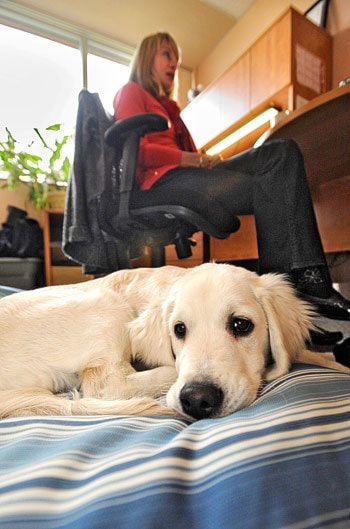At only five months old, Magnus strutted down the halls of Yukon College with ease.
Covered from tail to snout in golden puppy fluff, he was more than willing to stop and greet anyone walking nearby.
His gentle nature and general all around puppy-ness make the British golden retriever the ideal fit for his new job.
Magnus is the school’s newest faculty member, offering students animal-assisted therapy when they come in for counselling sessions.
He’s “the quintessential therapy dog,” said Magnus’s two-legged partner, Angela Neufeld, a registered psychologist who works at the college.
Students can book an appointment to see Neufeld and Magnus when he is on campus every Thursday.
“That is the hope, that maybe this might attract some people to counselling who could have been more apprehensive or nervous about it,” Neufeld said.
According to the college, the 84 students who sought counselling for personal or mental health reasons in the 2012/2013 year was an increase of 15 per cent from the year before.
Magnus started working at the college in late September. Once a week he sprawls out on a large blue cushion in Neufeld’s office, meeting with students who make an appointment.
Starting a therapy session by talking about the dog - his new favourite toy or how his training is coming along - can be easier than diving right in to the situation that led a student to counselling.
“You can start by talking about the animal and what’s going on with them. You might be able to gradually start to relate it to what’s going on in the person’s life. It makes it a little less scary,” Neufeld said.
She uses the example of a student who comes in and finds Magnus sleeping.
“Maybe we talk about how that feels for them. Are they feeling rejected by Magnus? Is that disappointing? And then maybe how that relates to other experiences in their life where they haven’t felt included or been treated well.”
Animal-assisted therapy is not a new concept. It has been used in hospitals, nursing homes and schools, among many other places.
The animals have been shown to reduce anxiety in hospital patients with psychotic disorders or mood disorders, according to an article published by the American Psychiatric Association. Other research has found animals lower blood pressure, cause endorphins to be released and reduce loneliness.
But Neufeld warns it’s not a magic solution.
“It’s a little bit like watching paint dry. It’s not like there’s a big show where the dog is jumping around in hoops. It’s really about integrating the animal into how you engage with the client.”
Growing up, Neufeld said she once considered being a veterinarian. Working alongside Magnus gives her the best of both worlds.
“I was thinking about how could I integrate what I love into my work. I knew other people were doing this kind of work with animals, like horses,” she said.
“It just seemed like a good way to bring something I am passionate about into my work.”
He’s made friends both with students and staff.
“I’ve gotten emails from staff saying, ‘I was having a really crappy day and you came by with Magnus. Thanks so much,” Neufeld said.
The college is also considering expanding the pilot project to include visits to the residence to interact with students who are missing pets they had to leave behind at home.
Neufeld spent time this summer training for this new therapy option at Healing Hooves, a program in Cremona, Alberta.
The program works mostly with horses, but it also offers visitors a chance to work with dogs and other small animals.
Founder Sue McIntosh said she’s seen people make major improvements around the animals in the 13 years since the program started.
“The presence of the animal helps them feel safe and connected,” she said.
The program also puts a lot of emphasis on keeping the animals themselves happy and stress-free.
Neufeld was originally planning on bringing two dogs to work with her: Magnus and Ky, a 12-year-old retired sled dog.
But the older dog was finding the environment a little too stressful, she said.
So far Magnus has fit into his new role well, she said, especially considering how young he is. People are already making appointments specifically for when the puppy is in session.
“He’s flexible, he’s adaptable, he really just goes with the flow. He’s so far doing really well.SDRq
Contact Ashley Joannou at
ashleyj@yukon-news.com
